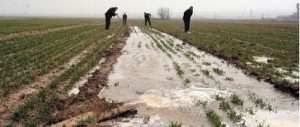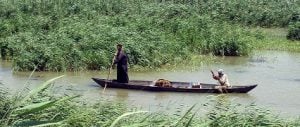Asparagus grown in Peru and sold in the United Kingdom is commonly held up as a symbol of unacceptable food miles, but a report has raised an even more urgent problem: its water footprint.
The study, by the development charity Progressio, has found that industrial production of asparagus in Peru’s Ica valley is depleting the area’s water resources so fast that smaller farmers and local families are finding wells running dry. Water to the main city in the valley is also under threat, it says. It warns that the export of the luxury vegetable, much of it to British supermarkets, is unsustainable in its current form.
The Ica valley is a desert area in the Andes and one of the driest places on earth. The asparagus beds developed in the last decade require constant irrigation, with the result that the local water table has plummeted since 2002 when extraction overtook replenishment. In some places it has fallen by eight metres each year, one of the fastest rates of aquifer depletion in the world.
The UK is the world’s sixth largest importer of “virtual water“, that is, water needed to produce the goods it buys from other countries, according to the environmental organisation WWF. Much of the UK’s thirst is directly related to the boom in high-value food imports in recent years. The market in fresh asparagus is typical; it barely existed before the end of the 1990s. Now the UK is the third-largest importer of fresh Peruvian asparagus, consuming 6.5 million kilogrammes a year.
Peru, meanwhile, has become the largest exporter of asparagus in the world, earning more than US$450 million a year from the trade. Around 95% of that asparagus comes from the Ica valley.
The expansion of the agricultural frontier in the region was made possible thanks to multimillion-dollar investments by the World Bank from the late 1990s on. In just 10 years, asparagus cultivation has exploded to cover nearly 100 square kilometres of reclaimed desert. Some of the largest producers have received loans from the World Bank’s commercial investment arm totalling US$20 million or more over that period. The trade has created around 10,000 new jobs in a very poor area, contributing significantly to Peru’s growth, but it has already provoked conflict. When a World Bank executive went to investigate complaints about the water shortages in April he was shot at.
“The water tragedy unfolding in this region of Peru should set alarms bells ringing for government, agribusiness and retailers involved in Ica’s asparagus industry,” said Progressio report author Nick Hepworth.
The report accuses supermarkets and investors, including the World Bank, of failing to take proper responsibility for the impact of their decisions on poorer countries’ water resources. “We need action now to ensure water is used sustainably in Ica and beyond,” said Hepworth.
Two wells serving up to 18,500 people in the valley have already dried up. Traditional small- and medium-scale farmers have also found their water supplies severely diminished.
Juan Alvarez’s experience is typical. His family has farmed the Ica valley for four generations. He employs 10 people through the year, with up to 40 jobs for workers in peak asparagus season, but he says those livelihoods are under threat.
The wells on his farm used to hit water at 55 metres and he could pump 60 litres of water a second from them. Now some have dried out and where there is still water he has to drill down to 108 metres and can extract only 22 litres a second even at that depth.
Alvarez told researchers: “Agro-exporters came with new government policies and tax exemptions. They bought water rights and started buying wells very far away. They have created jobs and that’s important, but the reality is they are depleting the water resources and when the water is gone, they will leave. But what future is there for us? We will never leave.”
For smaller farmers the crisis is even more acute. Elisa Gόmez and her family own a small farm next to one of the largest asparagus exporters and have to buy water for irrigation from the local canal, but the industrial production has made it hard to survive. “We pay for water for 15 days twice a year. But the soil is not as productive as before and dries out in just three days. Now the land is so dry the water drains away much faster.”
The rights to the wells in their part of the valley have all been sold to the exporter. “Those of us who didn’t sell land suffered water shortages, so many people were forced to sell anyway. The exporters just wait for people to get tired and sell them cheap dry land,” she said.
The large-scale exporting companies are not immune from the crisis of over-extraction either. They are facing rising costs for their water. They have been deepening existing wells, buying up old ones from neighbouring land and piping water across huge distances. Some also are alleged to have got round a ban on new wells by paying off officials.
One of the largest and most modern of Peru’s fresh asparagus producers, which supplies 18% of exports to the UK, spoke to Progressio researchers anonymously. The producer has received loans from the World Bank’s lending arm. Its chief executive said that the water levels in some wells were falling by as much as two metres a year. All its wells are licensed and legal, but he said regulation was weak and there was no inspection of what people extracted.
“Peru provides the world with the best example of how to mismanage water. We desperately need to rationalise water use in the Ica. We are spending huge sums just to survive.”
He argued that big businesses such as his were at the forefront of science to use water efficiently but traditional farmers used water carelessly.
Competition for diminishing global water resources is emerging as one of the most pressing concerns for business as well as development organisations. Leading retailers have told The Guardian privately that water shortages in the areas where they source fresh fruit and vegetables out of season are at the top of their list of priorities when they check how sustainable their businesses are.
The water shortages on Peru’s Pacific coast are expected to get worse as climate change shrinks the Andean glaciers that feed the Ica river system.
Promoting food for export has been a key plank in World Bank policy for developing countries. Its investment arm, the International Finance Corporation (IFC), said in a statement that it aims to promote sustainable development through investment in private sector companies, which it requires to commit to minimising their water use: “We define sustainability as providing economic growth opportunities for the poor and protecting the environment and the rights of vulnerable communities.”
How far the policy helps the poorest in those countries remains a subject of fierce debate among international development experts. Progressio is not calling for an end to the asparagus export business. “The area relies on asparagus for employment. We are not saying the trade itself is wrong but supermarkets and investors have to take responsibility for finding more of a balance,” said Petra Kjell, an environmental policy officer.
We asked the leading UK retailers to comment but only two were able to do so in the time available. Marks & Spencer said: “We have a range of responsible water-use projects under way and have strengthened our farming standards to include greater focus on water efficiency.”
Tesco said: “We are pleased that Progressio has highlighted Tesco’s role in raising industry standards in water management in areas such as the Ica valley. We have a strong record in this area and our Nurture standard is regularly reviewed and improved. We acknowledge there is more to do and so we are continually working with our suppliers to help them minimise their environmental impact, including water use.”
Names of farmers have been changed.
Case study
Alicia Flores and her family live in the village of Callejón de los Espinos in Peru’s Ica valley. Each house in the village normally receives water for about one hour, three times a week.
They used to get two hours’ water four times a week, but about four years ago the water pressure dropped off dramatically, as agricultural exporters extracted more and more groundwater. Then the 2007 earthquake exacerbated the problem by damaging infrastructure. Now, when the water is on, the family is only able to collect half the amount of water they used to, so they are reduced to 10 litres of water per person, per day. The World Health Organisation says a person needs five times that amount to maintain health.
Like most people in the village, Alicia’s husband works for the asparagus exporters. They say the working conditions are good but pay and benefits have been cut since the global economic crisis.
“We have seen water pressure dropping in the past years since the agro-exporters came, but if the water runs out and they leave, we will have no work and no water. What will happen to our children then?” asked one villager.
Names have been changed
https://www.guardian.co.uk
Copyright © Guardian News and Media Limited 2010
Homepage image from USAID


